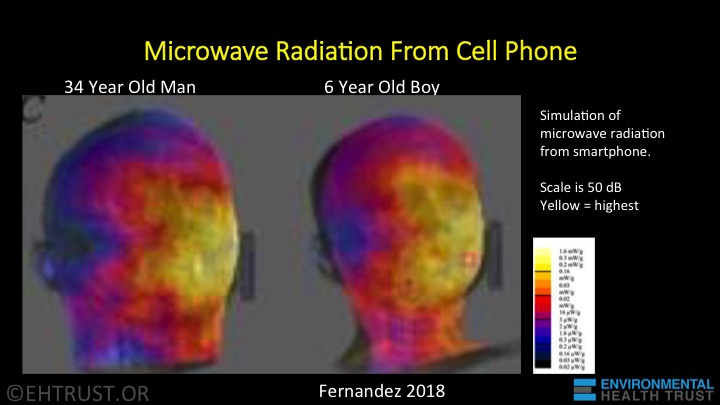https://www.sciencedirect.com/science/article/pii/S0013935118302561
Highlights
More cell phone radiation is absorbed by children’s inner brain tissues than adults’.
- -Children’s radiofrequency radiation exposure should be reduced.
- -Further research to evaluate the risks to the eye from use of VR is urgently needed.
- -It is biologically relevant and feasible to reduce the standards’ averaging volume.
- -Current methods to determine wireless device compliance should be revised.
-
Abstract
Children’s brains are more susceptible to hazardous exposures, and are thought to absorb higher doses of radiation from cell phones in some regions of the brain. Globally the numbers and applications of wireless devices are increasing rapidly, but since 1997 safety testing has relied on a large, homogenous, adult male head phantom to simulate exposures; the “Standard Anthropomorphic Mannequin” (SAM) is used to estimate only whether tissue temperature will be increased by more than 1 Celsius degree in the periphery. The present work employs anatomically based modeling currently used to set standards for surgical and medical devices, that incorporates heterogeneous characteristics of age and anatomy. Modeling of a cell phone held to the ear, or of virtual reality devices in front of the eyes, reveals that young eyes and brains absorb substantially higher local radiation doses than adults’. Age-specific simulations indicate the need to apply refined methods for regulatory compliance testing; and for public education regarding manufacturers’ advice to keep phones off the body, and prudent use to limit exposures, particularly to protect the young.
More about the study (credit to Environmental Health Trust)
Experts warn that injuries to vision, hearing and brain could prove irreversible
June 5, 2018
(Washington DC) In an innovative study published today in Environmental Research, researchers simulated microwave radiation from Virtual Reality(VR) with a video-streaming cell phone in a cardboard box placed in front of the eyes. Specific areas of the eyes and critical parts of the brain absorbed between 2 to 5 times more cell phone radiation in the youngest child model compared to the adult model. Children’s health specialists are concerned that higher exposures to unprecedented levels of microwave radiation pose risks of permanent damage to vision, hearing and brain development, and cancer.
This publication is the first to extend FDA computer-based anatomical modeling used for surgical devices to examine absorption of microwave radiation from cell phones held in virtual reality.
“Children’s vision, brain and hearing could be permanently impaired by this untested radiation,” stated Devra Davis Ph.D., MPH, a study co-author, and President of Environmental Health Trust (EHT). “This study shows children’s eyes absorb significant amounts of radiation. Children are more vulnerable because their eyes are still developing. Early life insults could mean earlier vision decline. In addition, the eyes contain few blood vessels, so they have no way to cool off.”
“The long-term ramifications of such exposures need to be addressed,” stated co-author Robert Morris M.D., Ph.D., EHT Senior Medical Advisor.
“Two-way microwave radiation transceivers, in the form of Smartphones, should not be used directly in front of children’s eyes and brains,” cautions University of Utah Prof. Om Gandhi, an electrical engineer who is one of the original developers of cell phone testing protocols.
Another study author, Meg Sears, associate at the Ottawa Hospital Research Institute in Canada, and Chair of Prevent Cancer Now, stated: “Children should be protected from microwave radiation. For any wireless device, using airplane mode after an adult downloads the program will greatly reduce microwave radiation.” She added, “The same radiation powering communications is used in chemical industries and products to accelerate reactions. This is efficient in commercial biochemistry, but can spell trouble during sensitive brain development.”
Dr Davis refers to the recent Phonegate scandal -she stated that even more recalls are expected as the European Union has updated their cell phone testing protocols after the government of France released hundreds of cell phone radiation tests that measured excessive radiation exposures when the phone was tested in contact with the body. The release of the test data folowed pressure from the Phonegate Alert Association.
“Studies of the developing brain have led the Centers for Disease Control (CDC) and Prevention and the U.S. Environmental Protection Agency to issue guidelines to keep toxic exposures to lead and other agents as low as feasible during childhood”, commented Dr. Davis, a former Senior Advisor to the CDC Lead Poisoning Advisory Committee and the National Institutes of Health (NIH). “We require special seatbelts and carseats as well as bike helmets for the young, recognizing that they merit greater protection. It makes no sense to assume that they can safely be exposed to levels of radiation that have never been evaluated for their long-term impacts on growth and development, especially in light of growing evidence that such radiation can damage plants, migrating insects, and other animals, and increase the risk of cancer,” she noted.

